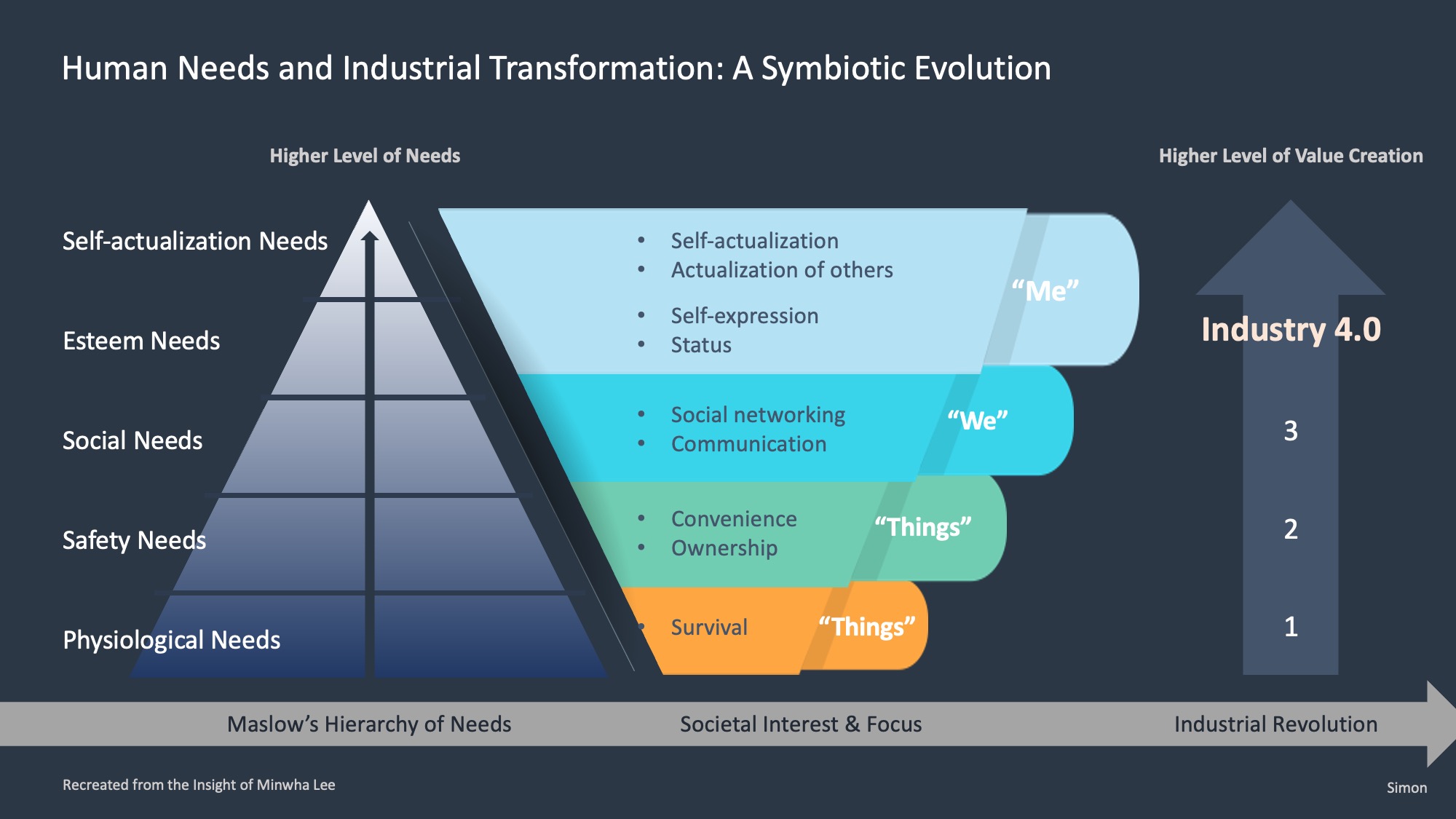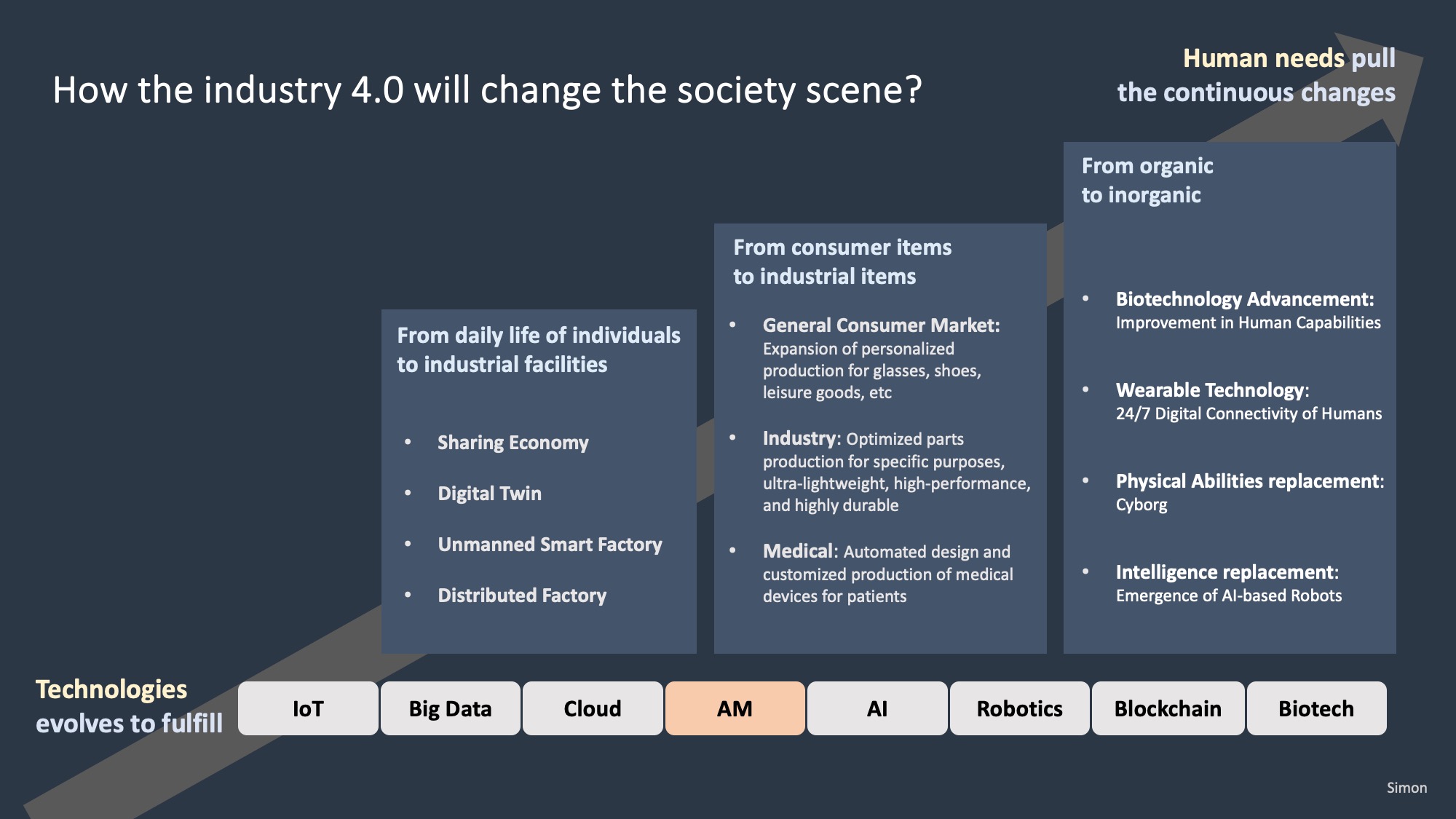I sometimes find myself more intrigued by “know-why” than “know-how.” As a believer in the burgeoning role of additive manufacturing (AM) in future production, I’ve spent time exploring ‘how’—how to streamline AM processes, how to integrate AM into existing systems seamlessly, and how to drive groundbreaking innovations of AM, etc. Yet, amid this maze of technicalities, a fundamental question has increasingly captured my attention: “Why should AM be an integral part of the future of manufacturing?”
In this article, we will examine the intrinsic relationship between advancing technologies and evolving human needs while investigating the rise of 3D printing within the context of Industry 4.0.
Human Needs and Industrial Transformation: A Symbiotic Evolution
The advent of the Fourth Industrial Revolution represents more than just a technological shift; it reflects the ongoing evolution of technological innovations in response to growing human needs. This dynamic interplay between technology and human needs is far from new and has recurred throughout history. To better understand the progression of human needs, one can turn to Maslow’s Hierarchy of Needs, a psychological theory that categorizes these needs from the most fundamental to the most advanced. A study by Minwha Lee et al. (2018) further elaborates on the relationship between these evolving human needs and the emergence of new technologies, leading to subsequent industrial revolutions.
Maslow’s framework begins with basic physiological needs, such as food, water, and shelter, before advancing to safety, love, belonging, and esteem, ultimately culminating in self-actualization. As each level of human needs is satisfied, individuals progress to the next level, catalyzing the development of new technologies designed to meet these evolving needs. Over time, the focus has shifted from fulfilling basic physical necessities to enriching societal connections. Currently, we observe a growing emphasis on meeting esteem needs and facilitating self-actualization, which is primarily centered on the individual or the “Me.”
Each industrial revolution throughout history has corresponded with these changing needs as follows:
- Physiological and Safety Needs: Survival and Ownership
- First and Second Industrial Revolutions: These phases were primarily driven by the need to address survival, ownership, and basic necessities like food and shelter. The success of these revolutions spread technological innovation across societies, reducing working hours and increasing wages, thus laying the foundation for higher-level needs.
- Social Needs: Connection and Communication
- Third Industrial Revolution: Defined by computers, automation, and the rise of Social Networking Sites (SNS), this era connected people globally, fostering a sense of community and laying the groundwork for integrating the physical and cyber worlds.
- Esteem Needs: Self-Expression, Creation, and Innovation
- Fourth Industrial Revolution (Industry 4.0): Driven by self-expression, status, and the human desire for creation and innovation, this phase is marked by disruptive innovation. The transition to Industry 4.0 represents an attempt to create new value and wealth through fulfilling human desires in further steps. Robotics and 3D Printing gain traction as traditional manufacturing faces challenges in this new industrial transformation.
The current transition gives rise to a ‘digital twin’ society, where every aspect of the physical realm is connected to its cyber counterpart through IoT, sensors, AI, and other data-gathering methods. This lays the groundwork for a ‘smart’ physical society that’s fine-tuned by AI, thereby paving the way for future advancements.
As human needs continue to evolve, with a growing demand for integration between the physical and cyber worlds, 3D printing takes center stage. It acts as a pivotal physical enabler in the framework of Industry 4.0, aligning perfectly with our growing needs for personalization, flexibility, and innovation. In doing so, AM encapsulates the boundless potential of the Fourth Industrial Revolution, serving as the bridge between human aspirations and technological possibilities in the tangible world.
Needs Addressed by AM: Personalization, Creativity, and Beyond
Despite their robustness, traditional manufacturing processes often wrestle with challenges such as inflexibility, waste, rigid design constraints, and protracted production cycles. These factors escalate costs and curtail innovation, aesthetics, and the ability to meet personalized needs.
Enter 3D printing, a revolutionary solution that is transforming the manufacturing landscape. Unlike conventional methods that depend on molds and cutting tools, AM constructs objects layer by layer from digital designs, facilitating on-demand production and complex geometries. Here are the human needs to be addressed by AM:
- Personalized Needs: AM’s approach enables unmatched customization, catering to individual preferences and requirements. From fashion to automotive, AM empowers consumers to be creators, aligning products with personal identities.
- Self-Esteem and Self-Respect: AM fosters self-expression through design, art, and innovation. 3D printing is a platform for creativity, allowing people to see their ideas materialize, enhancing self-esteem and self-respect.
- Creativity, Knowledge, and Innovation: AM accelerates the implementation of innovations, granting designers and engineers the freedom to explore and learn. It catalyzes knowledge, understanding, performance, beauty, and artistic expression.
- Sustainability and Efficiency: Dramatically reducing waste and speeding up production timelines, AM is not merely an alternative; it’s an accelerator for a new epoch of innovation and efficiency, ideally attuned to the principles of Industry 4.0.
By transcending the limitations of traditional manufacturing and resonating with the growing human desires for self-creation, personalization, and self-fulfillment, AM is not just a technological advancement; it symbolizes the endless possibilities of the Fourth Industrial Revolution.
The Future of 3D Printing in Digital Manufacturing
The future of AM holds promise with innovation across sectors like hardware, material, and software, but also in the larger landscape of digital transformation.
1. Data-Centric Technologies:
- IoT and Connectivity: As industries lean towards data-driven processes, AM systems will increasingly be augmented by IoT. This convergence will enable predictive maintenance, remote monitoring, and real-time adaptability.
- Data-Driven Manufacturing: Future AM will rely heavily on big data and analytics for real-time optimization, enabling businesses to respond to market changes dynamically.
2. Convergence of Digital and Physical Worlds:
- Digital Twins and Simulation: The next decade will see the full integration of digital twins in AM, making real-time simulations the norm rather than the exception. This will revolutionize product development cycles.
- Cyber-Physical Systems: Future AM will seamlessly integrate digital and physical worlds, thus becoming a critical component in Industry 4.0 ecosystems.
3. Automation and Intelligence:
- AI and Automation: AI’s role is evolving from automating design and process optimization to incorporating predictive analytics and adaptive quality control. The true market potential of AM will be unlocked by making the technology easier to use.
4. Data Security:
- Blockchain and Integrity: As digital threats escalate, blockchain will become an integral part of AM, ensuring data integrity and providing tamper-proof records for the entire manufacturing lifecycle.
At this juncture, a pivotal question then arises: “Is Industry 4.0 an opportunity for AM, or is AM an opportunity for Industry 4.0?” This query probes the symbiotic relationship between AM and Industry 4.0, signaling that both can be stimulating drivers of each other.
Conclusion
3D printing is not merely another production method but a transformative catalyst in our current industrial landscape. The impact of AM is magnified because it aligns closely with the exponential digital technologies that drive today’s digital transformation, thus catering to evolving human needs. Far from being just a tool, AM serves as a keystone in the unfolding architecture of Industry 4.0.
Subscribe to Our Email Newsletter
Stay up-to-date on all the latest news from the 3D printing industry and receive information and offers from third party vendors.
You May Also Like
Further Understanding of 3D Printing Design at ADDITIV Design World
ADDITIV is back once again! This time, the virtual platform for additive manufacturing will be holding the first-ever edition of ADDITIV Design World on May 23rd from 9:00 AM –...
3D Printer Maker EVO-tech Reborn as NEVO3D — Once More With Feeling
EVO-tech was a 3D printing service and original equipment manufacturer established in 2013 and based in Schörfling am Attersee, Austria. The company produced high-quality material extrusion systems featuring linear bearings,...
3D Systems Brings 3D Printed PEEK Cranial Implant to the U.S. with FDA Clearance
For more than 10 years, 3D Systems (NYSE:DDD) has worked hand-in-hand with surgeons to plan over 150,000 patient-specific cases, and develop more than two million instruments and implants from its...
CDFAM Returns to Berlin for Second Annual Symposium
The second CDFAM Computational Design Symposium is scheduled for May 7-8, 2024, in Berlin, and will convene leading experts in computational design across all scales. Building upon the first event...


































